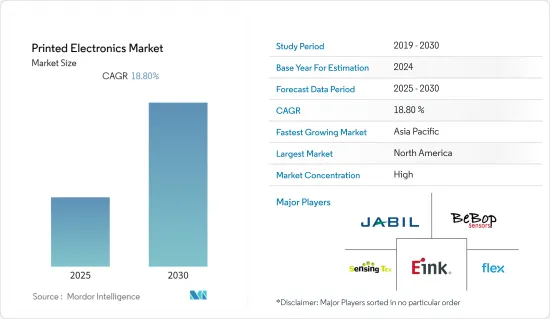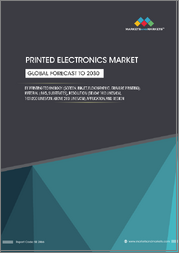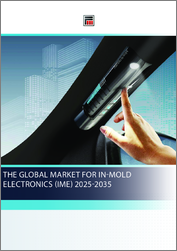
|
시장보고서
상품코드
1629793
프린티드 일렉트로닉스 : 시장 점유율 분석, 산업 동향 및 통계, 성장 예측(2025-2030년)Printed Electronics - Market Share Analysis, Industry Trends & Statistics, Growth Forecasts (2025 - 2030) |
||||||
프린티드 일렉트로닉스 시장은 예측 기간 동안 CAGR 18.8%를 기록할 것으로 예상됩니다.

주요 하이라이트
- 낮은 제조 비용, 디지털 인쇄 기술의 발전, 자금 조달 활동의 활성화, 의료 산업의 신기술 지향 등이 의료 산업에서 인쇄 전자 시장 성장의 요인입니다.
- 인쇄 전자공학은 다양한 기판 위에 광전자 또는 인쇄 전자공학을 기재하는 것을 말합니다. 널리 사용되는 인쇄 기술에는 플렉소 인쇄, 잉크젯, 그라비아 인쇄, 스크린 인쇄 등이 있습니다. 이러한 기술은 천, 종이, 플라스틱과 같은 기판에 인쇄합니다. 이 인쇄 방법은 웨어러블 기기, 센서, 소프트 스크린 등에 널리 사용되고 있습니다.
- 의료 부문은 통합된 나노 스케일 센서, 전자, 미세유체에서 첨단 합성 물질에 이르기까지 프린티드 일렉트로닉스 재료의 최신 개발로 인해 큰 혜택을 누리고 있습니다. 또한, 기술 혁신과 소비자의 높은 지지 덕분에 의료 모니터링, 진단 및 약물전달을 위한 보다 신축성 있고 유연하며 컨포멀한 바이오센서의 개발이 진행되고 있습니다.
- 프린티드 일렉트로닉스기술의 사용은 환자의 원격 모니터링을 가능하게 하는 데 매우 유익한 것으로 입증되었습니다. 의료 서비스 제공자는 웨어러블 및 인쇄 센서와 같은 사용하기 쉽고 저렴한 장치를 활용하여 원격으로 환자를 추적할 수 있으며, 이를 통해 불필요한 방문을 줄이고, 환자와의 시간을 최적화하며, 커뮤니케이션을 개선할 수 있습니다. 비용 측면에서도 큰 이점이 있습니다. 헨켈에 따르면, 향후 25년 동안 인쇄 전자공학은 2,000억 달러의 비용 절감 효과를 가져다 줄 것으로 예상됩니다.
- 장기적으로 경쟁의 격화와 여러 경쟁자의 등장으로 인해 비용이 하락할 것으로 예상됩니다. 의료 산업에서는 디지털 전환과 새로운 기술에 대한 관심이 이를 촉진하고 있습니다. 전 세계 각국은 환자 치료에 혁명을 일으키기 위해 의료 지출을 늘리려고 노력하고 있습니다.
- 그러나 의료 산업은 큰 위험이 수반되는 것을 감안할 때 규제가 엄격합니다. 따라서 모든 신기술은 대량 생산에 들어가기 전에 몇 가지 규제 점검을 거쳐 품질 요구 사항을 충족시켜야 합니다. 이는 조사 대상 시장의 성장을 가로막는 중요한 과제 중 하나입니다. 또한, 지역 간 표준화가 이루어지지 않은 것도 시장 개척에 어려움을 겪고 있습니다.
- COVID-19는 조사 시장의 성장에 상당한 영향을 미쳤습니다. 특히 초기 단계의 급격한 환자 수 증가는 의료 시설의 부담을 증가시켜 첨단 디지털 기술에 대한 투자를 촉진했습니다. 또한, 팬데믹 기간 동안 개인 건강 추적 장치의 보급도 증가했습니다. 팬데믹의 영향은 줄어들고 있지만, 이러한 추세는 예측 기간 동안 지속될 것으로 예상되며, 이는 조사 대상 시장에 성장 기회를 제공할 것으로 보입니다.
프린티드 일렉트로닉스 시장 동향
고령자 증가가 성장을 견인
- 세계 인구가 증가함에 따라 노인 인구도 증가하고 있습니다. 세계보건기구(WHO)에 따르면 2030년까지 60세 이상 인구 비율은 2020년 10억 명에서 14억 명으로 증가하고 2050년에는 약 21억 명으로 두 배로 증가할 것으로 예상되며, 80세 이상 인구는 2020-2050년 사이 3배 증가한 4억 2,600만 명에 달할 것으로 예상됩니다.
- 노인은 건강 관련 문제를 겪기 쉽기 때문에 이러한 추세는 의료 서비스 제공자가 치료뿐만 아니라 추적 장치 및 센서를 사용하여 지속적으로 건강 상태를 추적하는 것을 포함하여 전반적인 노인 관리를위한 혁신적인 의료 솔루션 개발에 집중하도록 촉구하고 있습니다.
- 프린티드 일렉트로닉스는 의료 서비스 제공업체가 이 모든 것을 원격으로 수행할 수 있는 실현 가능한 솔루션으로 빠르게 부상하고 있습니다. 이 기술은 센서와 같은 추적 및 건강 모니터링 구성요소를 스마트워치나 기타 웨어러블 기기, 때로는 옷 속에 일상적으로 통합할 수 있게 해주기 때문입니다.
- 인쇄 전자 기술의 추가 혁신은 환자의 의복에서 직접 전자 의료 기록으로 직접 지속적인 데이터 전송을 용이하게하여 의료 제공자와 환자 간의 상호 작용을 줄이는 동시에 환자로부터받는 데이터의 품질을 향상시킬 수 있습니다. 또한 센서 기술과 마이크로일렉트로닉스의 발전은 새로운 치료의 임상 검사를 개선할 수 있습니다. 예를 들어, 피부에 붙이는 접착식 패치에 전자장치를 장착하면 의사는 약품의 투여량을 제어하고 모니터링할 수 있습니다.
아시아태평양이 큰 시장 점유율을 차지
- 아시아태평양은 중국, 인도와 같은 국가의 존재로 인해 가장 빠르게 성장하는 지역으로 추정됩니다. 가처분 소득과 의료비 지출 증가, GDP 성장, 브랜드 포지셔닝 개선에 대한 필요성 증가 등이 프린티드 일렉트로닉스 시장을 견인하는 요인으로 작용하고 있습니다.
- 아시아태평양의 프린티드 일렉트로닉스 시장은 그 규모와 다양성으로 인해 다른 지역과 차별화됩니다. 이 지역은 전 세계 인구의 약 60%를 차지하며, 20세기에만 약 4배 성장했습니다. 이러한 인구 증가는 경제적 잠재력 측면에서 큰 이점으로 작용하여 프린티드 일렉트로닉스 산업 공급업체들에게 큰 도움이 되고 있습니다.
- 또한, 특히 일본, 중국 등의 국가에서 노인 인구의 증가는 이 부문의 혁신적인 건강 추적 기기에 대한 수요가 상대적으로 높기 때문에 조사 대상 시장의 성장을 뒷받침하는 요인 중 하나입니다. 예를 들어, 일본은 2022년 10월 기준 65세 이상 인구가 29%를 넘어서는 등 세계에서 가장 높은 고령자 비율을 보이고 있습니다. (출처: 총무성).
- 또한, 이 지역의 많은 사람들이 당뇨병, 비만, 심장병과 같은 생활습관병에 시달리고 있습니다. 이에 따라 이러한 질병을 조기에 진단하는 것에 대한 사회적 관심이 높아지고 있으며, 이는 이 지역의 조사 시장 성장에 유리한 시장 시나리오를 형성하고 있습니다.
- 또한, 이 지역의 의료 인프라를 개발하기 위한 공공 및 민간 부문의 투자가 증가함에 따라 이 지역의 의료 부문에서 프린티드 일렉트로닉스제품의 사용 사례가 확대되고 있습니다. 또한, 이 지역은 빠르게 세계 전자 산업의 제조 거점이 되고 있습니다. 또한, 프린티드 일렉트로닉스 업체들이 이 지역에서의 입지를 확대하기 위해 투자를 늘리고 있는 것도 연구 시장에 유리하게 작용하고 있습니다.
프린티드 일렉트로닉스 산업 개요
의료 산업 내 프린티드 일렉트로닉스 시장은 경쟁이 치열하며, 현재 기술 전문성과 세계 입지를 갖춘 소수의 주요 업체들이 시장을 주도하고 있습니다. 주요 기업들은 시장 점유율과 수익성을 높이기 위해 지속적인 성장을 위한 제품 개발 및 전략적 공동 이니셔티브에 집중하고 있습니다. 그러나 의료 산업에서 프린티드 일렉트로닉스에 대한 수요가 증가함에 따라 여러 신규 진입자들이 등장하면서 경쟁이 치열해질 것으로 예상됩니다. 이 시장의 주요 기업으로는 Jabil Inc., Bebop Sensors Inc, E Ink Holdings Inc, Sensing Tex S.L. 등이 있습니다.
지난 11월, 헨켈과 프린티드 일렉트로닉스 전문기업 쿼드 인더스트리즈(Quad Industries)는 스마트 헬스 패치 혁신을 저비용으로 빠르게 실현할 수 있는 새로운 컨셉을 개발했습니다. 벤더는 엔지니어가 개념의 기능을 신속하게 테스트할 수 있도록 설계된 12개의 전극으로 구성된 데모 패키징을 제공하기 시작했습니다.
지난 10월, 프린티드 일렉트로닉스 기술 제공업체인 볼테라(Voltera)는 신축성 있고 부드럽고 유연한 표면에 회로를 인쇄하는 다이렉트 드로잉 기술을 사용하여 연성 하이브리드 전자제품을 인쇄할 수 있는 새로운 플랫폼인 NOVA를 발표했습니다. NOVA는 스크린 인쇄를 사용하지 않기 때문에 빠른 설계 반복이 가능하며, 잉크젯과 같은 다른 적층형 프로토타이핑 옵션보다 높은 성능을 제공한다는 것이 회사 측의 설명입니다.
기타 혜택
- 엑셀 형식의 시장 예측(ME) 시트
- 3개월간의 애널리스트 지원
목차
제1장 소개
- 조사 가정과 시장 정의
- 조사 범위
제2장 조사 방법
제3장 주요 요약
제4장 시장 인사이트
- 시장 개요
- 산업 밸류체인 분석
- 산업의 매력 - Porter's Five Forces 분석
- 신규 참여업체의 위협
- 구매자의 교섭력
- 공급 기업의 교섭력
- 대체품의 위협
- 경쟁 기업 간의 경쟁 강도
- COVID-19의 시장에 대한 영향
- 기술 현황 - 인쇄 기술
- 플렉소 인쇄
- 잉크젯 인쇄
- 그라비어 인쇄
- 스크린 인쇄
- 기타 인쇄 기술
제5장 시장 역학
- 시장 성장 촉진요인
- 저비용 제조
- 노인 증가
- 디지털 인쇄 기술의 진화
- 시장 성장 억제요인
- 의료 산업의 엄격한 규제
- 지역 간의 표준화의 결여
제6장 시장 세분화
- 유형별
- 프린트 센서
- 가스 센서
- 온도 센서
- 바이오 센서
- 기타 인쇄 센서
- 스트레처블 일렉트로닉스
- 프린티드 RFID
- 프린트 센서
- 지역별
- 북미
- 유럽
- 아시아태평양
- 기타
제7장 경쟁 구도
- 기업 개요
- E Ink Holdings Inc.
- Carre Technologies Inc.
- Jabil Inc.
- Bebop Sensors Inc.
- Sensing Tex SL
- Coatema Coating Machinery GmbH
- Flex Ltd
- Agfa-Gevaert NV
- GSI Technologies
- DuPont de Nemours Inc.
제8장 투자 분석
제9장 시장 향후 전망
ksm 25.01.23The Printed Electronics Market is expected to register a CAGR of 18.8% during the forecast period.

Key Highlights
- The low cost of manufacturing, the evolvement of digital print technology, the rise in funding activity, and the healthcare industry's inclination towards newer technologies are the factors responsible for the growth of the printed electronics market in the healthcare industry.
- Printed electronics offer photonic and printed electronics on various substrates; some widely used printing technologies include flexography, inkjet, gravure, and screen printing. These techniques print on substrates such as cloth, paper, and plastics. This printing method is widely used on wearable devices, sensors, and flexible screens.
- The healthcare sector has profited significantly from the latest developments in materials for printed electronics, ranging from integrated Nanoscale sensors, electronics, and microfluidics to sophisticated synthetics. Moreover, innovations and high consumer adoption have led to the development of more stretchable, flexible, and conformal biosensors for medical monitoring, diagnostics, and drug delivery.
- The use of printed electronics technology has been proven to be significantly beneficial in enabling remote patient monitoring as the healthcare providers can leverage easy-to-use and affordable devices such as wearables and printed sensors to keep track of the patient remotely, resulting in reduced unnecessary visits, optimized time with patients, and improved communication. Cost is another significant benefit. According to Henkel, printed electronics are projected to save USD 200 billion over the next 25 years.
- In the long run, the costs are anticipated to decline owing to the growing competition and emerging presence of multiple players. Digital transformation and an inclination toward newer technologies in the healthcare industry fuel this. Countries worldwide are willing to increase their healthcare expenditure to revolutionize patient care.
- However, the medical industry is highly regulated, considering the high stakes involved; hence, any new technology has to undergo several regulatory checks and satisfy quality requirements before getting into mass production, which is among the significant factors challenging the studied market'smarket's growth. Furthermore, the lack of standardization across geographies also challenges the development of the studied market.
- COVID-19 had a considerable impact on the growth of the studied market. A sudden rise in the number of patients, especially during the initial phase, increased the burden on healthcare facilities, encouraging them to invest in advanced digital technologies. Furthermore, the penetration of personal health tracking devices also increased during the pandemic. Although the impact of the pandemic is reducing, such trends are expected to sustain during the forecast period, creating growth opportunities for the studied market.
Printed Electronics Market Trends
Increasing Geriatric Population to Drive the Growth
- With the increasing global population, the aged population is also increasing. According to the World Health Organization (WHO), by 2030, the share of the population aged 60 years and over is expected to increase from 1 billion in 2020 to 1.4 billion, which will double to about 2.1 billion by 2050. The number of persons aged 80 years or older is expected to triple between 2020 and 2050 to reach 426 million.
- As older people are more prone to health-related issues, such trends are encouraging healthcare service providers to focus on developing innovative healthcare solutions not only for treatment but also for the overall care of the aged population, which involves constantly tracking their health condition by using tracking devices and sensors.
- Printed electronics are fast emerging to be a feasible solution for healthcare service providers to do all this remotely, as the technology enables the integration of tracking and health monitoring components such as sensors into the day-to-day use of things such as smartwatches and other wearables and even in clothes in some cases.
- Further innovation in printed electronics technology can facilitate continuous data transmission from a patient's garment directly into their electronic health records, reducing interactions between providers and patients while improving the quality of the data received from the patients. Additionally, advances in sensor technology and microelectronics can also improve clinical trials of new treatments. For instance, electronics on adhesive patches placed on the skin can enable doctors to control and monitor the dosage of prescribed medicines.
Asia-Pacific to Hold a Significant Market Share
- Asia-Pacific is estimated to be the fastest-growing region owing to the presence of countries such as China and India. Increasing disposable income and healthcare expenditure, growing GDP, and the increasing need to position the brand better are some factors driving the market for printed electronics.
- Asia-Pacific printed electronics market is unique compared to the other regions because of its size and diversity. The region accounts for about 60% of the global population and has grown nearly four-fold in the 20th century alone. This rise in population is a huge advantage in terms of economic potential and aids the suppliers of the printed electronics industry.
- Additionally, the increasing geriatric population, especially in countries such as Japan, China, etc., is also among the factors supporting the studied market's growth, as the demand for innovative health-tracking devices is relatively higher among this segment. For instance, Japan has the highest senior population ratio in the world, with more than 29% of the population aged over 65 years as of October 2022. (Source: Ministry of Internal Affairs and Communications).
- Furthermore, a large pool of people from the region suffers from lifestyle-related diseases, such as diabetes, obesity, and heart disease, among others. This is raising the concern levels in societies to diagnose such diseases early, which is, in turn, creating a favorable market scenario for the growth of the studied market in the region.
- The increasing investment by the public and private sectors to develop the healthcare infrastructure across the region is also expanding the use cases of printed electronics in the region's healthcare sector. Furthermore, the region is fast becoming the manufacturing hub for the global electronics industry. Also, it works in favor of the studied market as printed electronics providers are increasing their investment to expand their presence in the region.
Printed Electronics Industry Overview
The printed electronics market in the healthcare industry is competitive and is currently dominated by a few major players with their technological expertise and global presence. Major players focus on product developments and strategic collaborative initiatives to sustain their growth to increase their market share and profitability. However, the increasing demand for printed electronics in the healthcare industry is expected to drive competition owing to the emergence of multiple new players. Some major players in the studied market include Jabil Inc., Bebop Sensors Inc., E Ink Holdings Inc., and Sensing Tex S.L, among others.
In November 2022, Henkel and Quad Industries, a specialist in printed electronics, developed a new concept to enable innovations for smart health patches at lower cost and with accelerated speed. The vendors started offering a demo package of twelve electrodes designed to allow engineers to quickly test the functionalities of their concepts, which significantly reduces the development time and lowers the overall design costs in the process.
In October 2022, Voltera, a printed electronics technology provider, launched NOVA, a new platform for printing flexible hybrid electronics that use direct write technology to print circuits on stretchable, soft, and conformable surfaces. According to the company, by not using screen printing, NOVA facilitates rapid design iteration while offering higher performance than other additive prototyping options such as inkjet.
Additional Benefits:
- The market estimate (ME) sheet in Excel format
- 3 months of analyst support
TABLE OF CONTENTS
1 INTRODUCTION
- 1.1 Study Assumptions and Market Definition
- 1.2 Scope of the Study
2 RESEARCH METHODOLOGY
3 EXECUTIVE SUMMARY
4 MARKET INSIGHTS
- 4.1 Market Overview
- 4.2 Industry Value Chain Analysis
- 4.3 Industry Attractiveness - Porter's Five Forces Analysis
- 4.3.1 Threat of New Entrants
- 4.3.2 Bargaining Power of Buyers
- 4.3.3 Bargaining Power of Suppliers
- 4.3.4 Threat of Substitute Products
- 4.3.5 Intensity of Competitive Rivalry
- 4.4 Impact of COVID-19 on the Market
- 4.5 Technology Snapshot - Printing Technology
- 4.5.1 Flexography
- 4.5.2 Inkjet Printing
- 4.5.3 Gravure Printing
- 4.5.4 Screen Printing
- 4.5.5 Other Printing Technologies
5 MARKET DYNAMICS
- 5.1 Market Drivers
- 5.1.1 Low Cost of Manufacturing
- 5.1.2 Increasing Geriatric Population
- 5.1.3 Evolvement of Digital Print Technology
- 5.2 Market Restraints
- 5.2.1 Heavy Regulations in Medical Industry
- 5.2.2 Lack of Standardization across Different Geographies
6 MARKET SEGMENTATION
- 6.1 By Type
- 6.1.1 Printed Sensors
- 6.1.1.1 Gas Sensors
- 6.1.1.2 Temperature Sensors
- 6.1.1.3 Biosensors
- 6.1.1.4 Other Printed Sensors
- 6.1.2 Stretchable Electronics
- 6.1.3 Printed RFID
- 6.1.1 Printed Sensors
- 6.2 By Geography
- 6.2.1 North America
- 6.2.2 Europe
- 6.2.3 Asia Pacific
- 6.2.4 Rest of the World
7 COMPETITIVE LANDSCAPE
- 7.1 Company Profiles
- 7.1.1 E Ink Holdings Inc.
- 7.1.2 Carre Technologies Inc.
- 7.1.3 Jabil Inc.
- 7.1.4 Bebop Sensors Inc.
- 7.1.5 Sensing Tex SL
- 7.1.6 Coatema Coating Machinery GmbH
- 7.1.7 Flex Ltd
- 7.1.8 Agfa-Gevaert NV
- 7.1.9 GSI Technologies
- 7.1.10 DuPont de Nemours Inc.



















